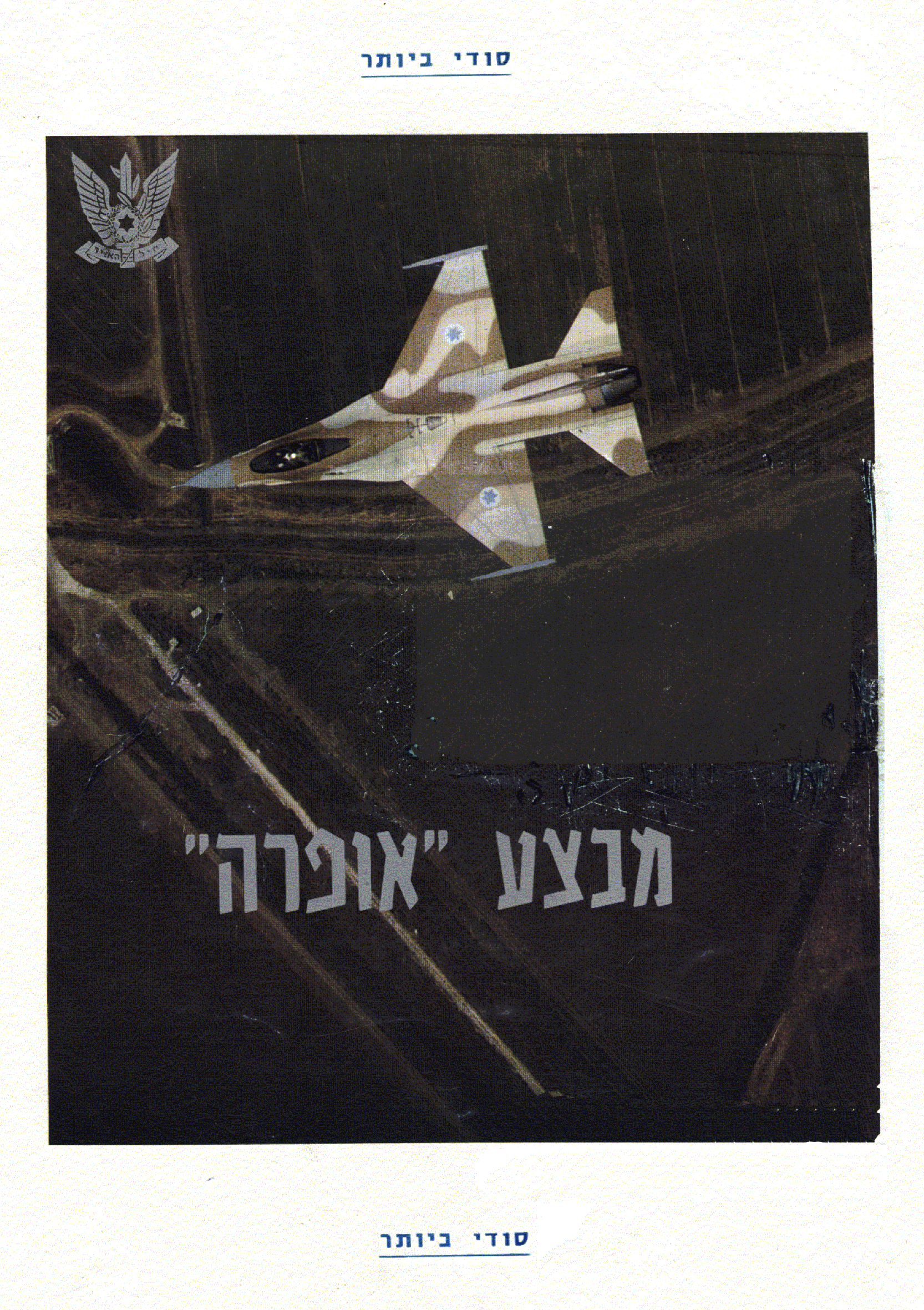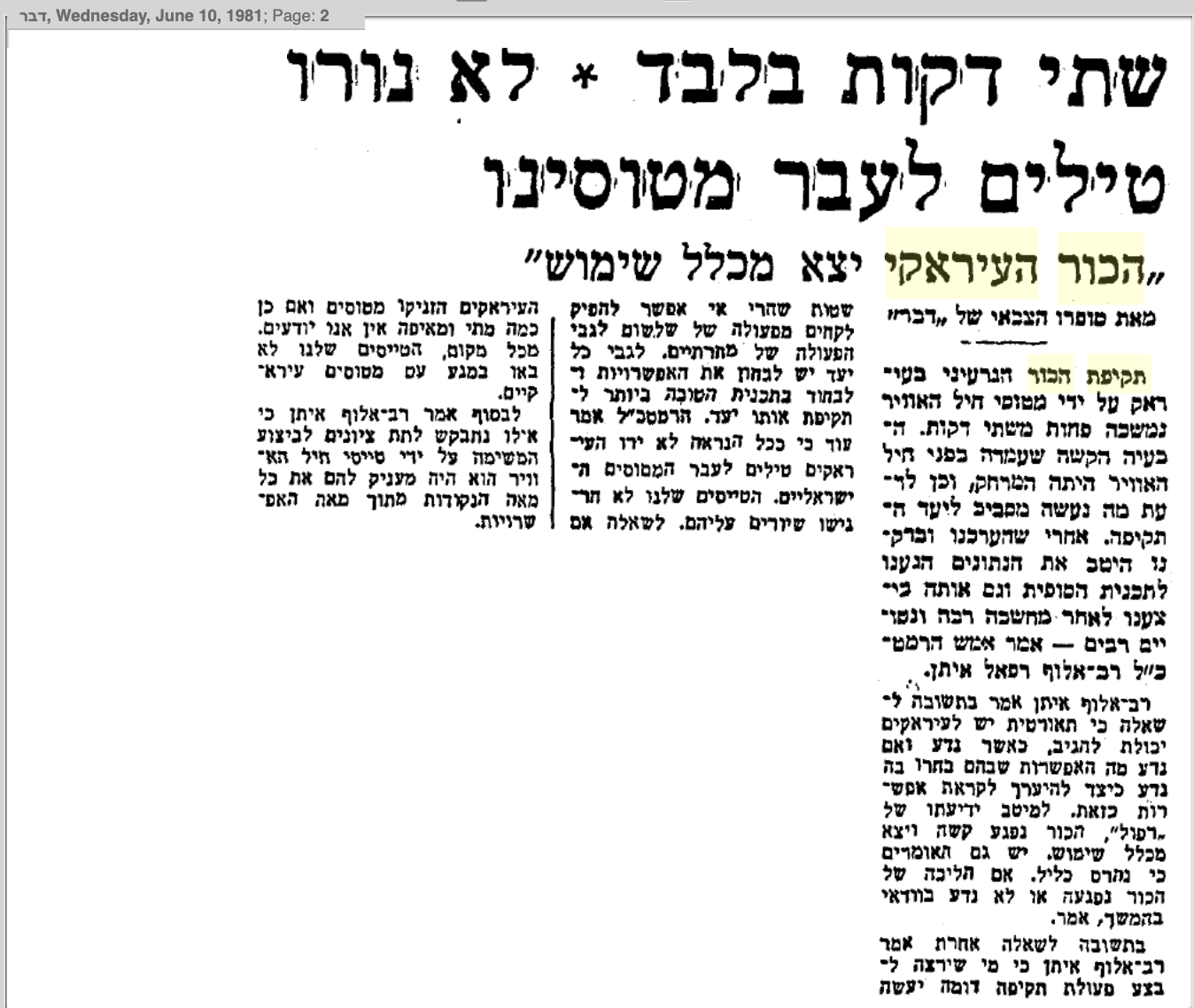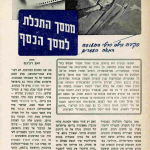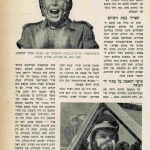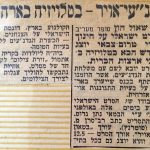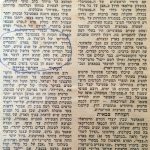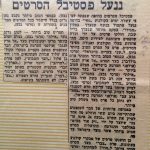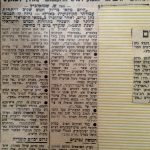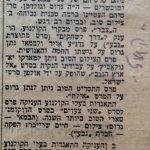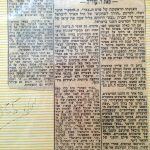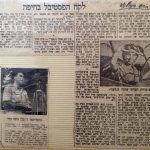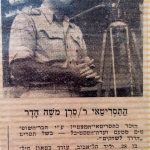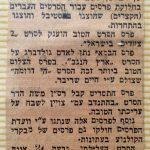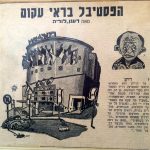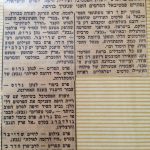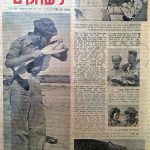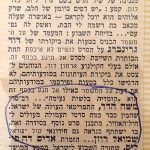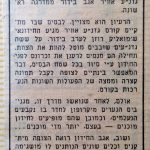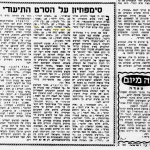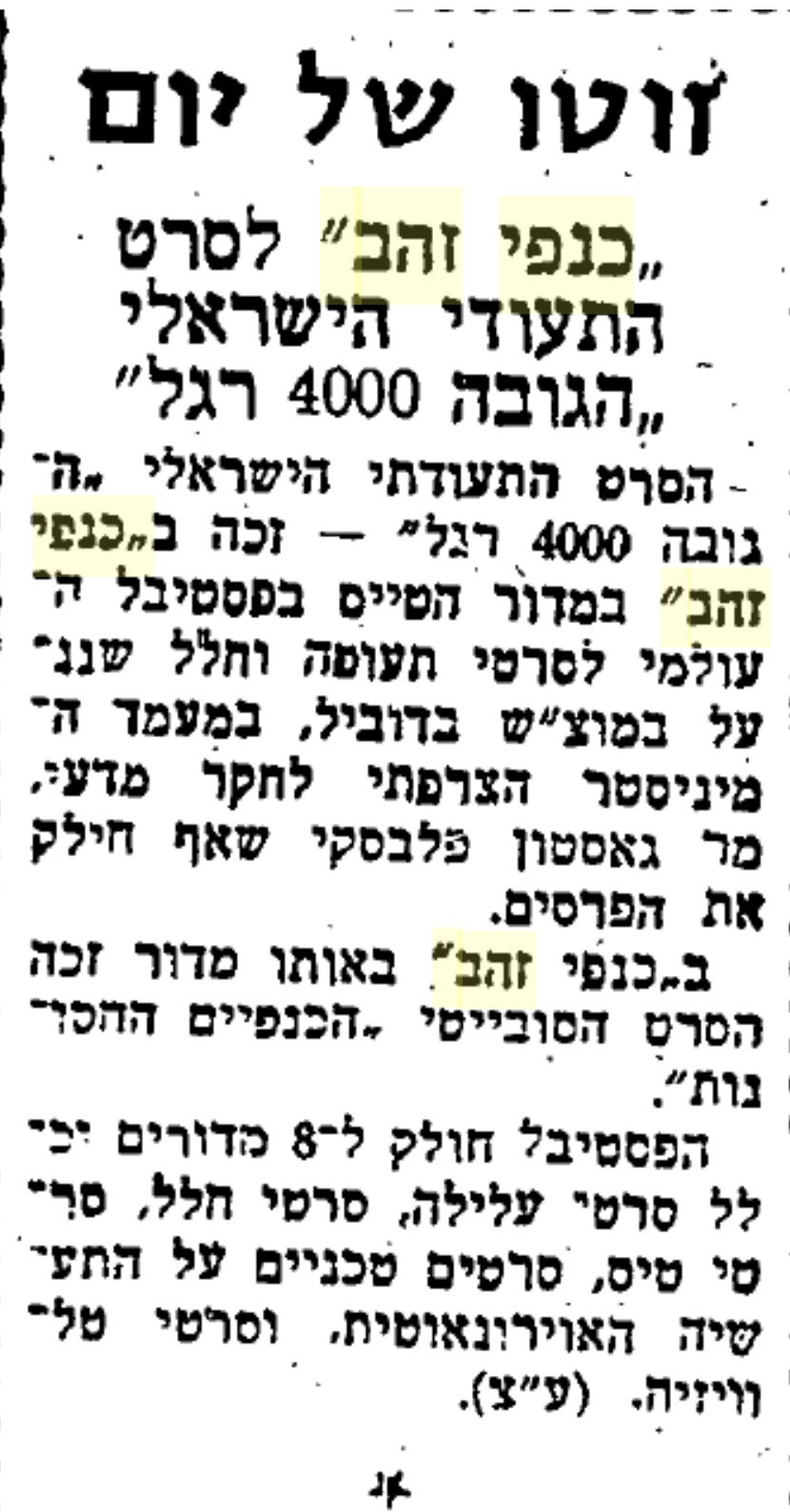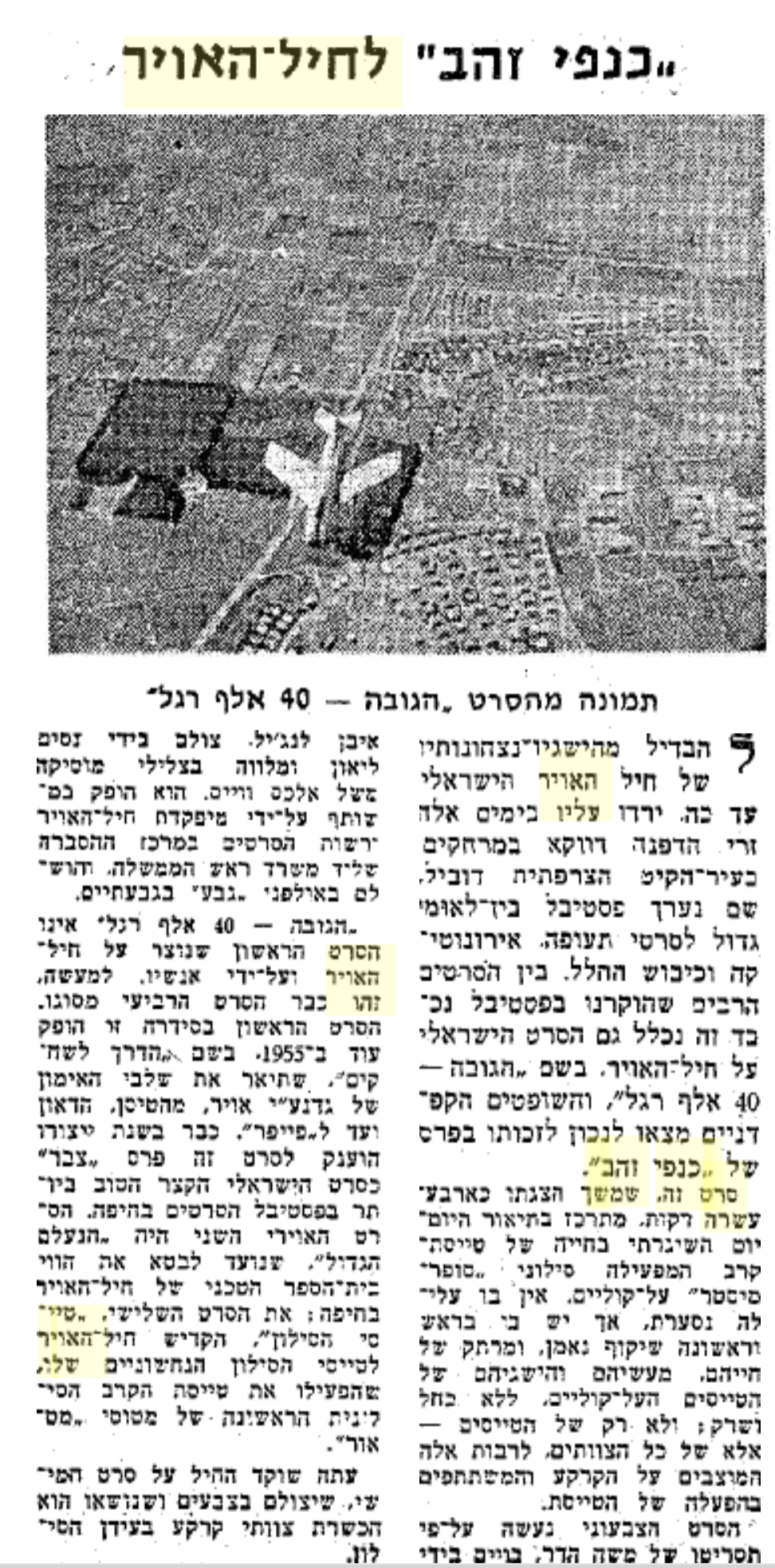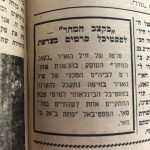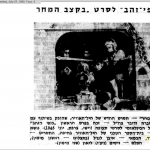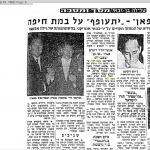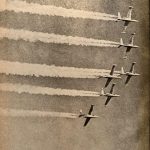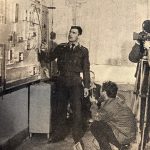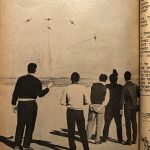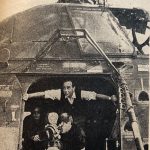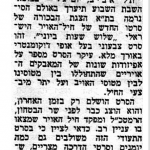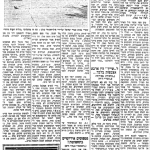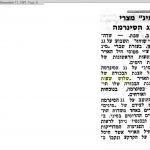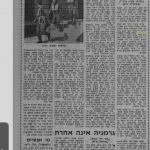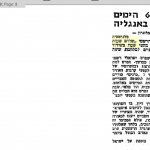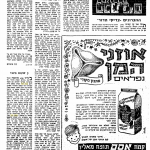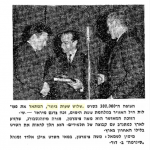AIR FORCE FILMS
Of all the many marketing campaigns and public affairs ventures, Pommy was particularly proud of what he calls "my film career in the Air Force." The first film, The Road to the Skies was produced in 1955
The Road to the Skies -1955
The Road to the Skies
The movie length 12.5 minutes
First Israeli Air Force movie
Won the Israeli Academy award, May 1955. Pommy won the tittle of screenwriter of the year.
The publicity films of the time were "characterized by pathos-saturated narration and landscape photography." Pommy said in an article by Nathan Gross, "A script has to know how to write …" Al Ha’meshmar Newspaper, November 5, 1967. "This time we didn't want another JNF film. Maybe that's why…the Prime Minister's Bureau rejected the movie, "The Road to the Skies." In the opening scene, the camera focuses on a maternity ward. Through the large windows, the camera zooms into the newborn nursery, displaying rows of bassinets. Each tiny bassinet affixed with a sign indicating the baby's profession: "farmer," "lawyer," "millionaire" and so on. In the background, the narrator says:
"If the vocation of a newborn could be known in advance, it would not be a problem to train pilots. However, since we have not yet reached this milestone, the road to the skies is still a long way off". Pommy said that the opening scene was not conservative enough for the Prime Minister's Office. Nevertheless, he was able to convince the IAF command to stand behind the film and with heavy pressure – the film came out.
The film describes the pre-military training phases of Gdna Air (the organization of the IAF, which aims to bring teenagers into aviation and air force issues). From the model aircraft, to the glider to the Piper. The film was made, so Gdna Air will introduce it at a civilian air defense conference in the United States. The film was shown on television across the United States.
“The Road to the Skies” launched Pommy's screenwriting career.
Production of the film ended in April 1955, few days before the Haifa Film Festival, when it was too late to be eligible to enter into the competition. Pommy did not give up. The day before the festival opened, he drove to Haifa, knocked on the festival director's door and got him to verbally agree that if he likes the film, it would be added into the competition. At midnight, three people entered the May movie theater: Pommy, the festival's director and screen projector.
"The Road to the Skies," the first Air Force film, entered the competition and won the "Sabra" award (Israeli "Oscar" in those days). In 1955, it was named "Best Movie of the Year." Pommy won the title: "Screenwriter of the Year."
"The critics have noted the difference between this film and other documentary films about the JNF and other institutions in the country, thanks to its human approach to the subject and the good humor that was woven throughout the movie."
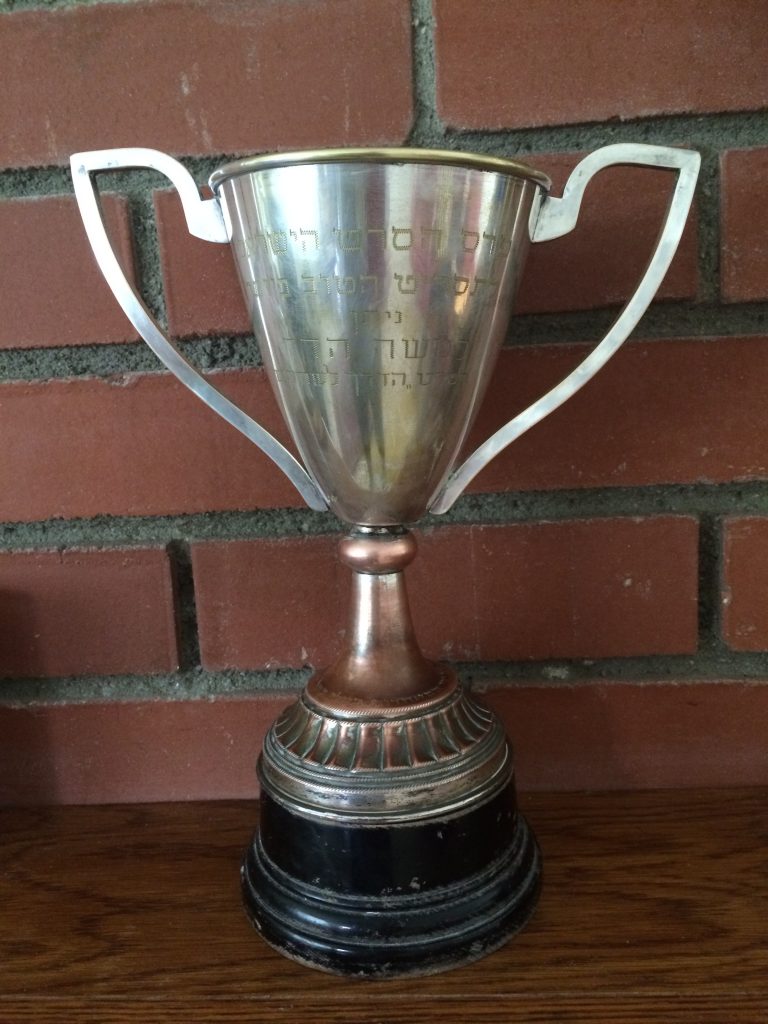
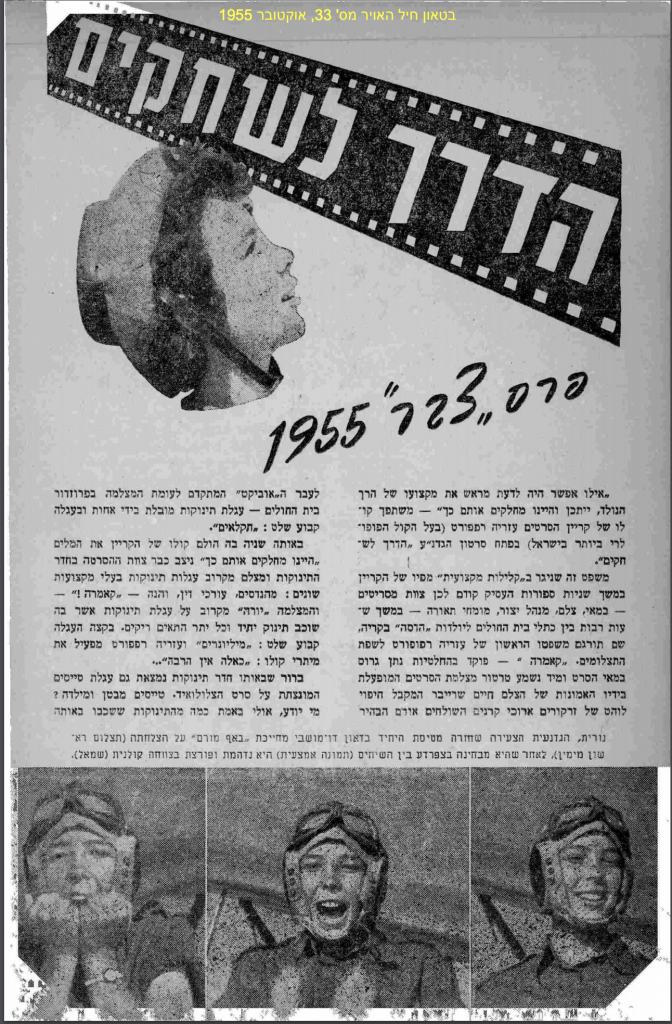
The Great Unknown 1956
The Great Unknown
Length: 13 minutes.
Director: Nathan Gross.
Participants: Shmulik Rosen, Nathan Kogan, Yair Predalsky and members of the Air Force Technical School and the IDF's first helicopter (see photo).
The short film intended to express the culture of Israeli Air Force Technical School in Haifa. The film is a propaganda for Gadna Avir, the military program that prepares young people for military service in the IAF. The propaganda is camouflaged so successfully that the viewer receives the information on Gadna Avir as a first-rate entertainment. "The idea is excellent," was written on August 2, 1956, in one of the daily newspapers. "Schmulik Rosen, the known quiz show host arrives for an evening of entertainment at the airbase, where the Gdana Avir’s course is being held. The contestants are six naughty Gadna Avir teenagers. As first step, they try to prepare for the quiz by exploring the entire air-base, which in the meantime allows the viewer to get a brief and a comprehensive picture of the various departments of the Air Force Technical School and the various course activities.
However, after realizing that this is not a way to prep, the boys sneak a microphone into the room where the questions are selected and of course the boys show up ready for the quiz – basically, too ready…
And again, listening to the quiz questions, the viewers are exposed visually to the various installations and tools that provide them an overview of the lives of these Gadna Avir youth.
The video is filmed well and tastefully edited. There is no doubt that this humorous docudrama reaches its goal better than any direct propaganda film.”
In this movie appears the first helicopter of the IAF, Hiller 360, by Sikorsky April 27, 1956
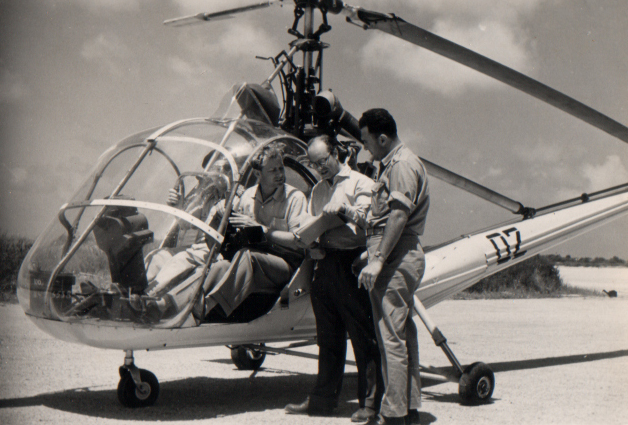
The First Helicopter of the IAF
Pommy first from right with the director, Nathan Gross
In this movie appears the first helicopter of the IAF, Hiller 360, by Sikorsky, April 27, 1956
The Crew
The crew in front of the first helicopter of the IAF, Hiller 360, by Sikorsky, April 27, 1956
Left: Nathan Gross (second), Schmulik Rosen (third), Moshe Hadar (fourth)
Right: Yair Fredalsky
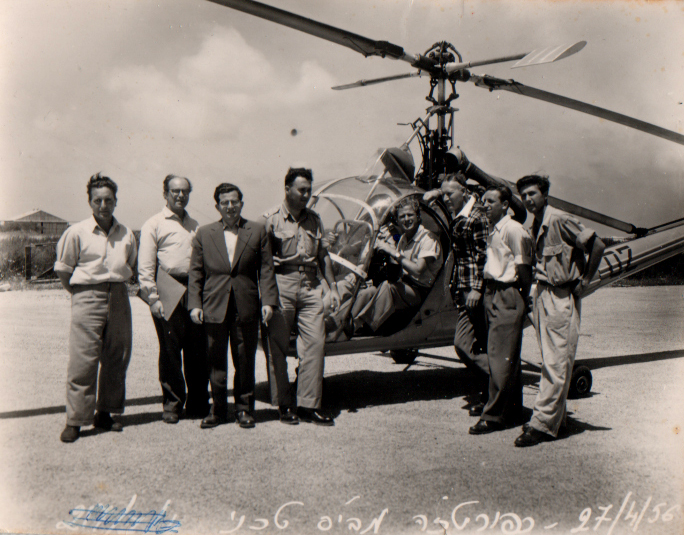
Altitude 40,000 -1961
Length: 14 minutes
Portrays the day-to-day life of a supersonic fighter squadron
The Golden Wing award “Altitude 40,000”, the first international film, Festival Mondial du Film Aeronautics and space in Deauville, France, September 14, 1963
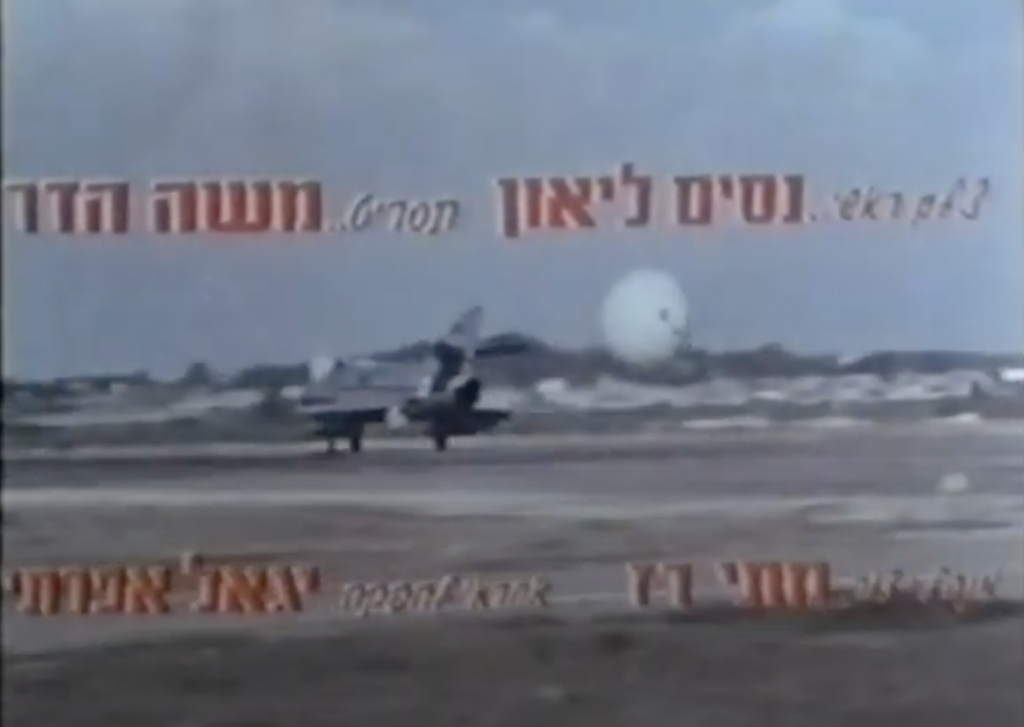
Screenplay: Moshe Hadar
Watch the Movie
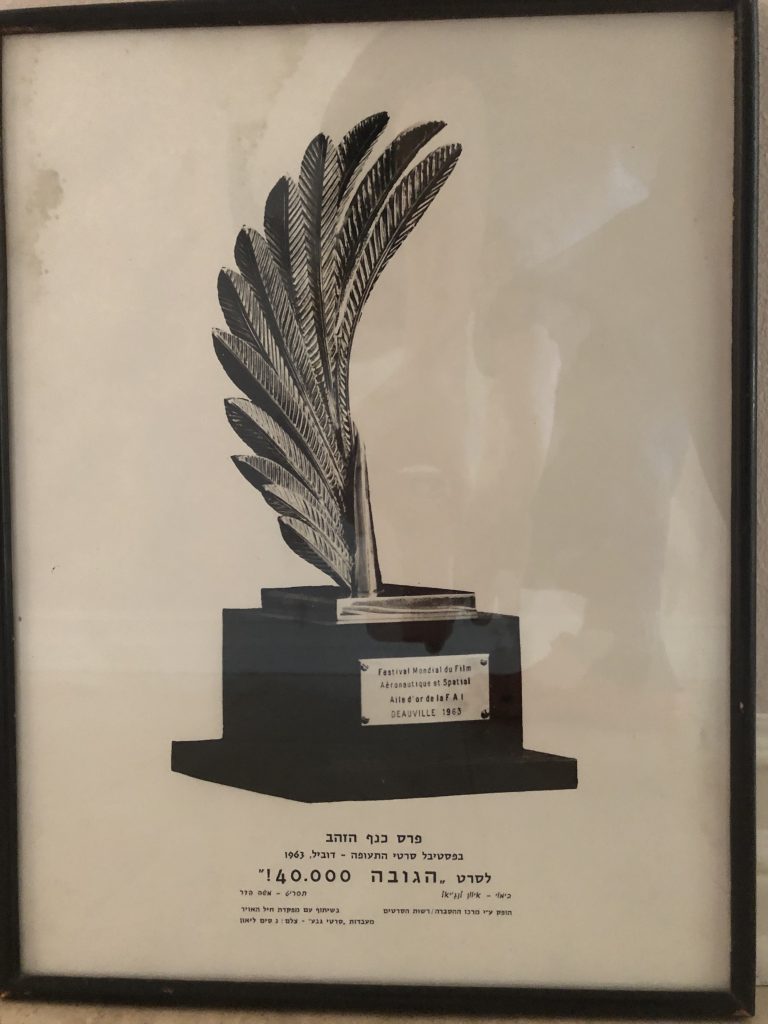
Altitude 40,000 was screened at the International Military Film Festival in Versailles, France, June 1964
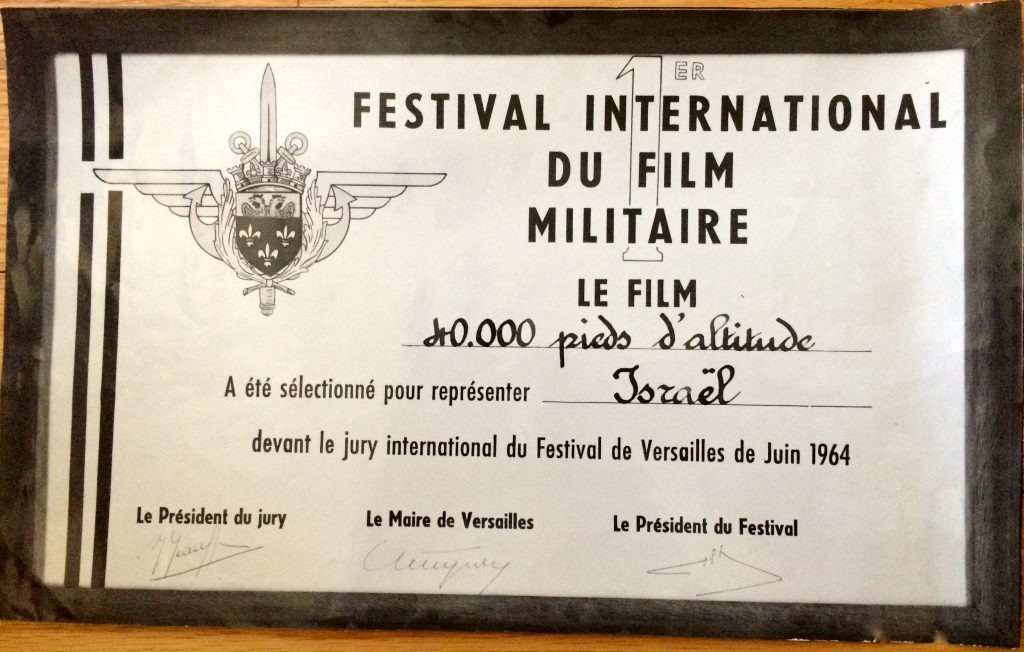
Meeting with Yuri Gagarin
At the Aerospace Film Festival in Deauville, France in 1963, Pommy befriended Russian cosmonaut Yuri Gagarin.
Yuri Gagarin was the first human in history to journey into outer space and the first to travel around the globe and return safely to the Soviet Union. Gagarin became an international celebrity and was awarded many medals and titles, including Hero of the Soviet Union, his nation's highest honors.
Pommy, asked him, if it was possible to live in space, he smiled and replied: "Yes, certainly possible, but you can also die." (later Yuri Gagarin was killed in a plane crash). At this international film festival, “Altitude 40,000”, won the first price, the Golden Wing Award. Before the awards were presented, Gagarin approached Pommy and told him how much he and his cosmonaut, Vladimir Komarov (who later perished in a space crash) marveled at the beauty of the film. Gagarin proudly informed Pommy that he had won the Golden Wing Award and that the Russian delegation voted for his film.
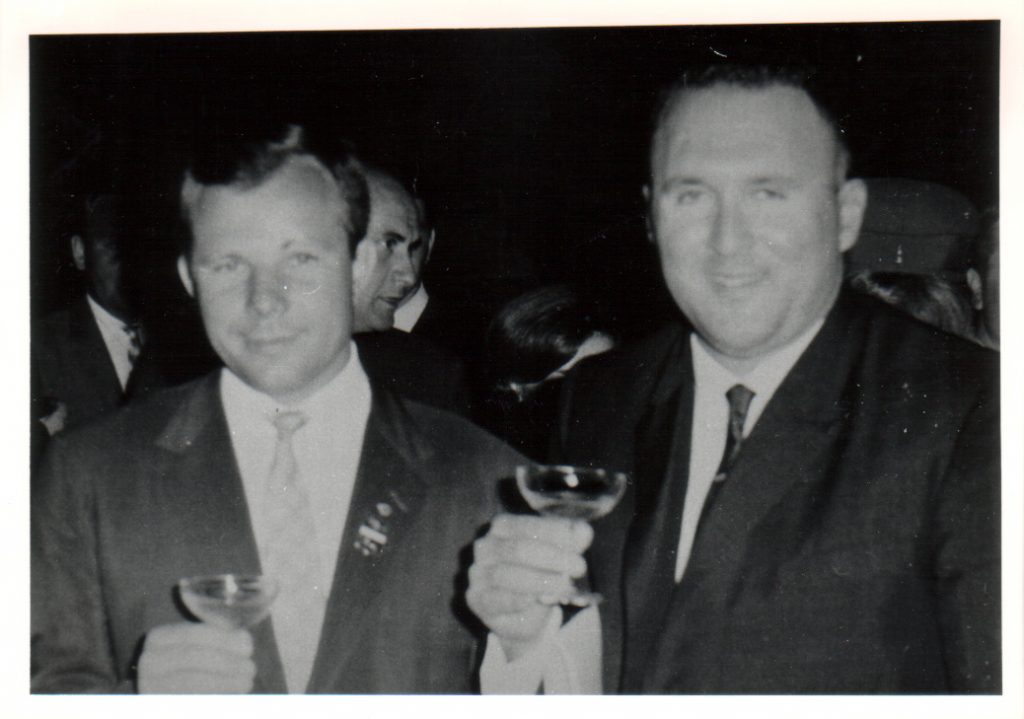
Altitude 40,000 article and report by Pommy
Camera rolling and clicking between whistling jets and blue skies
by Moshe Hadar
April-May 1961
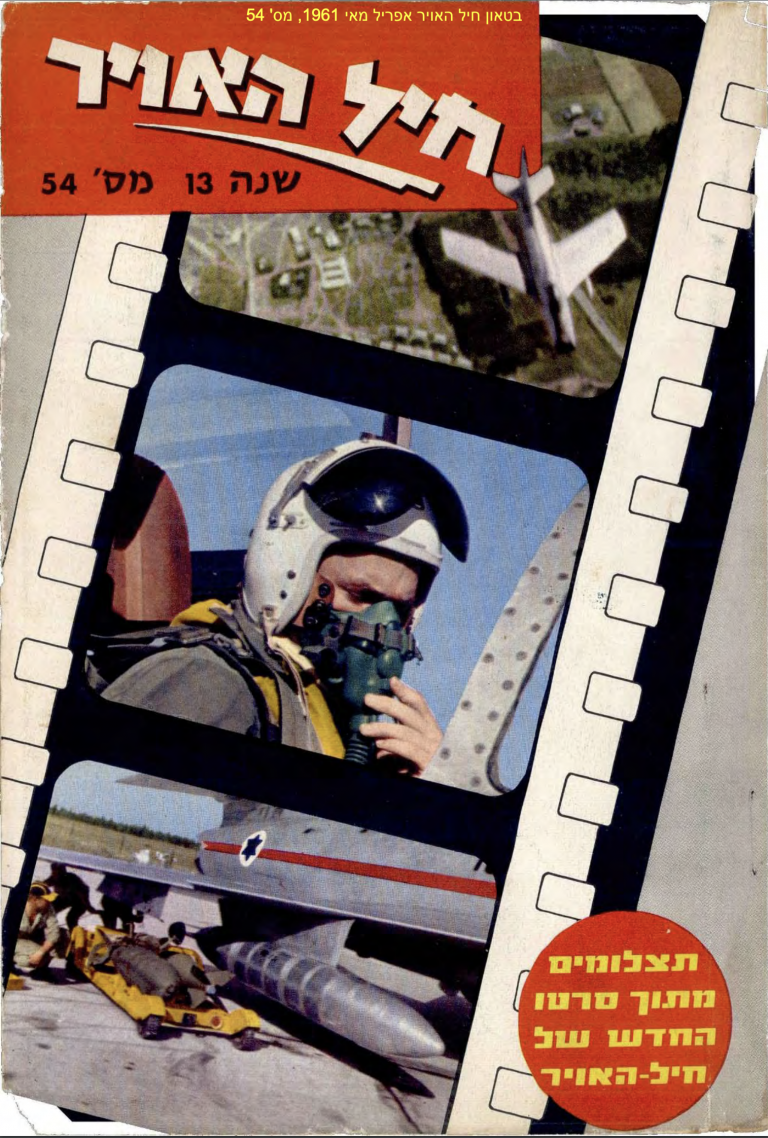
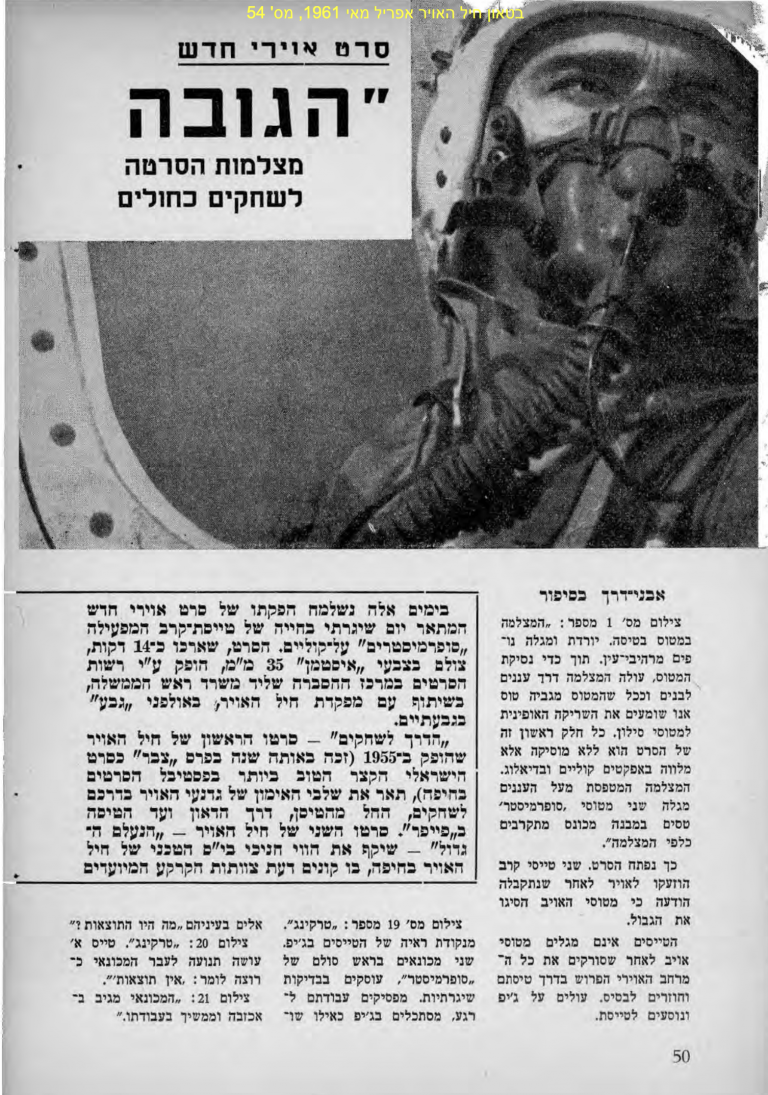
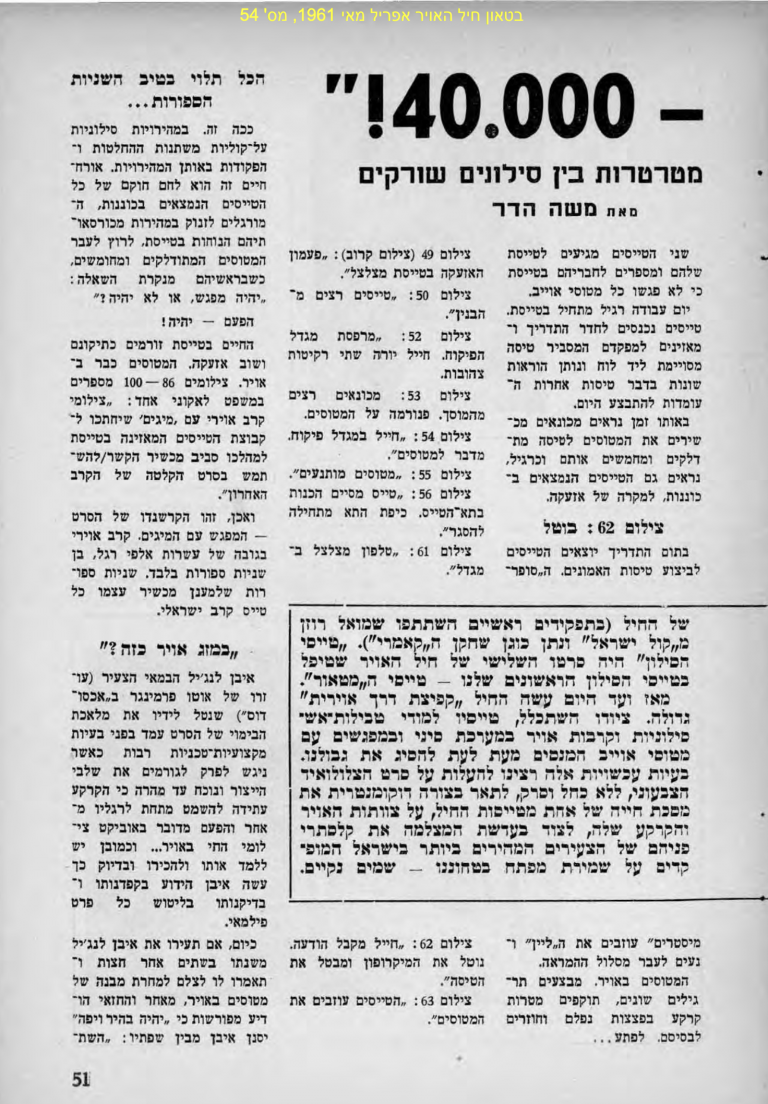
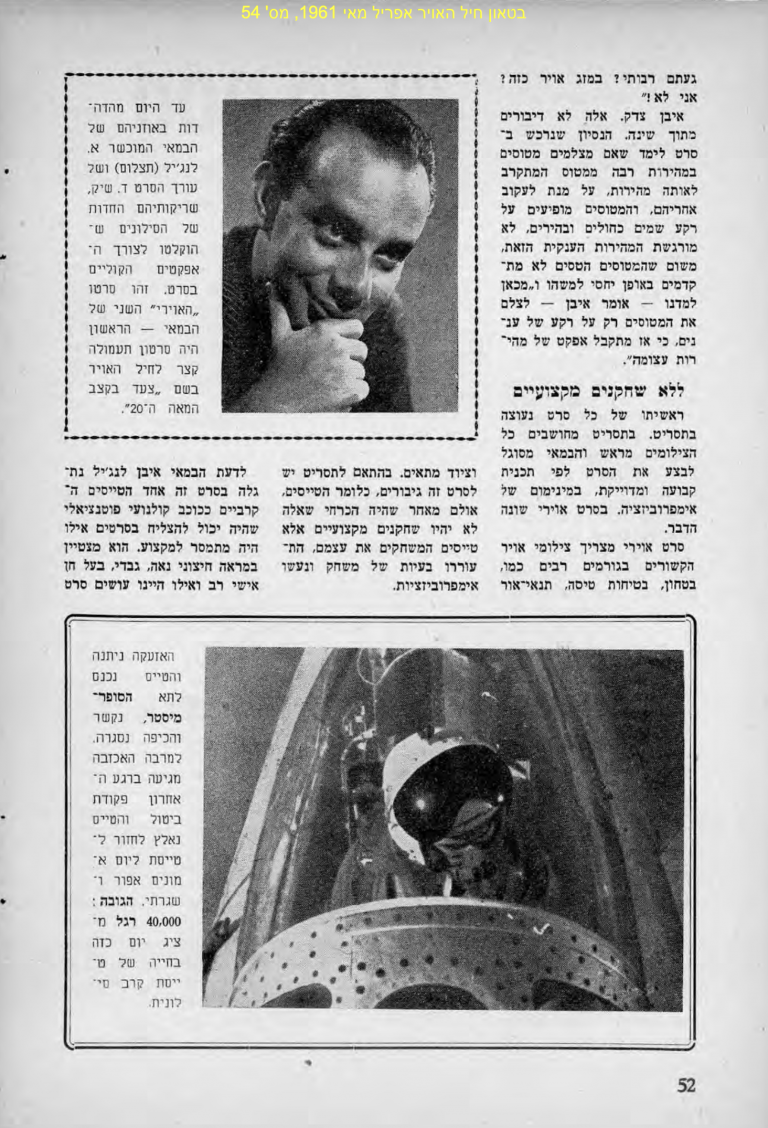
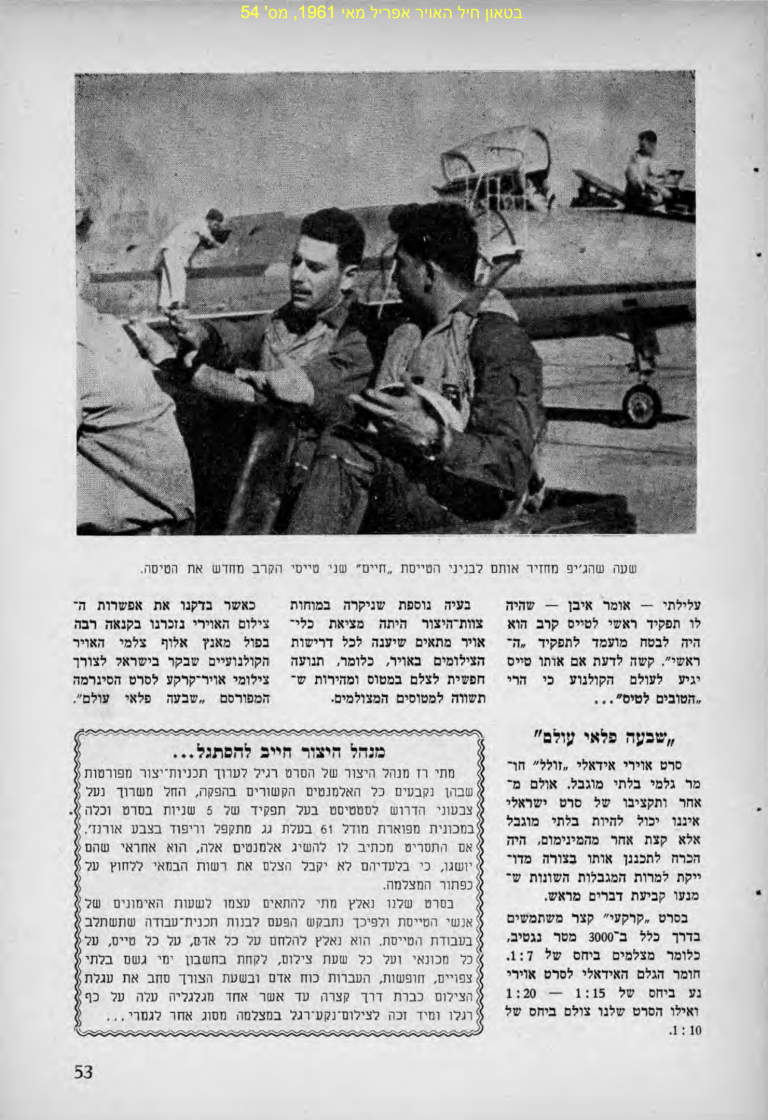
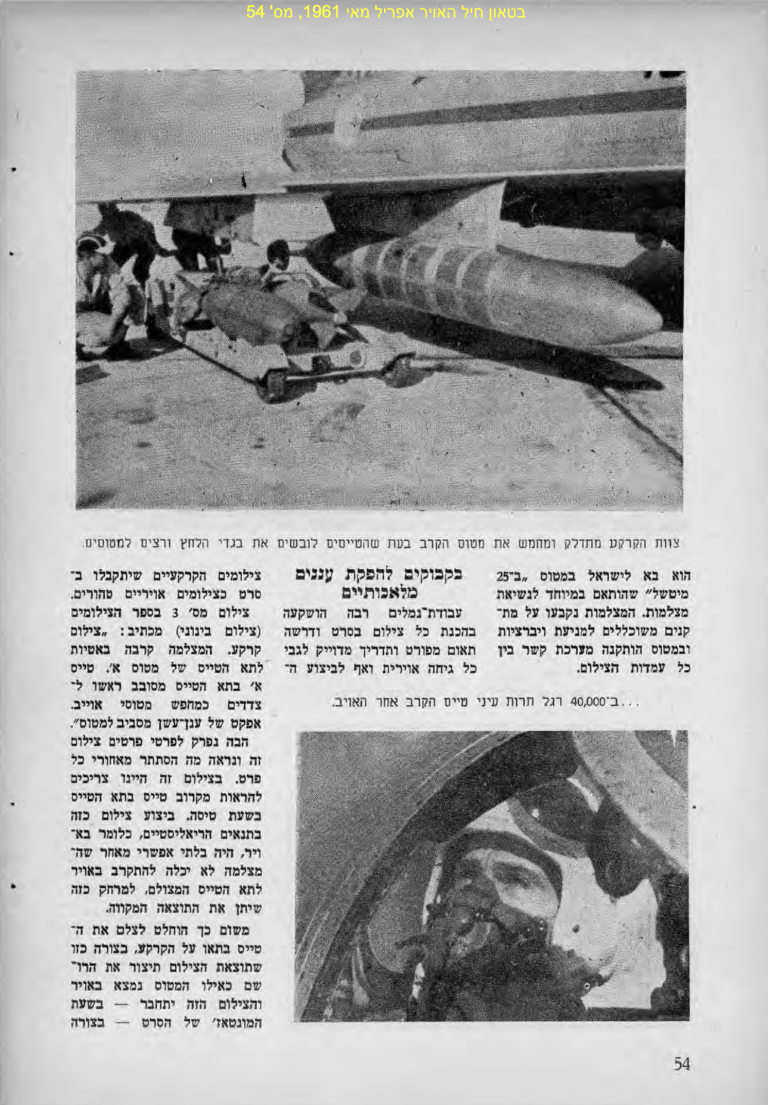
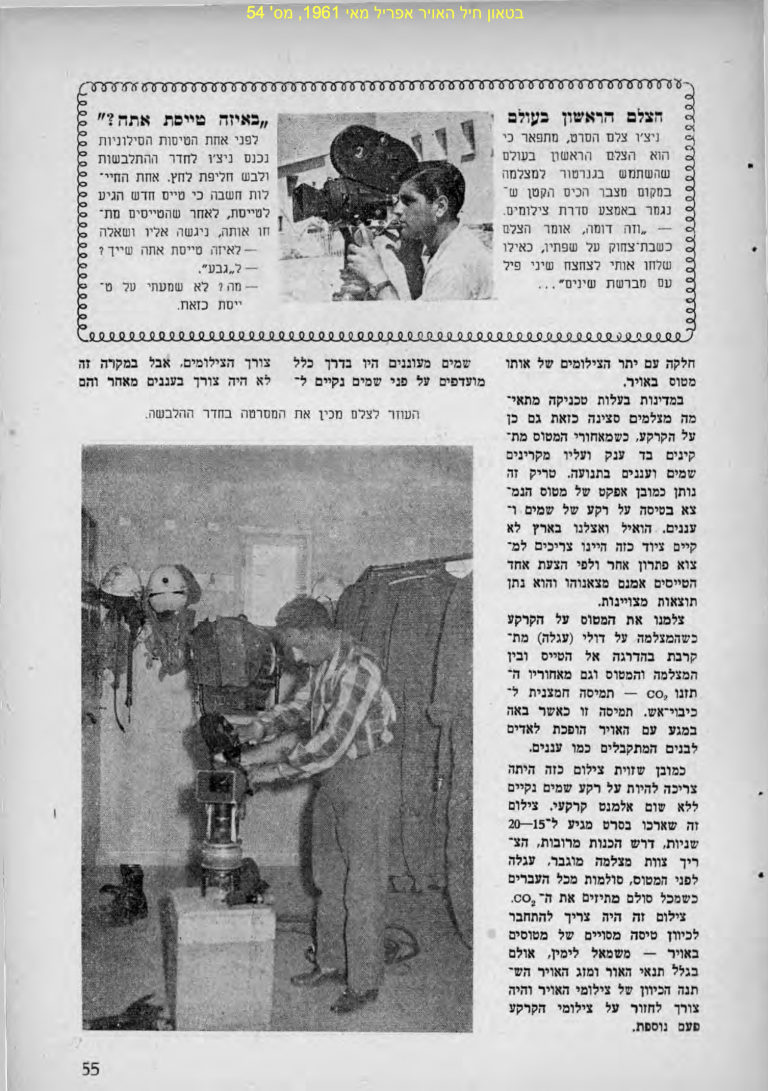

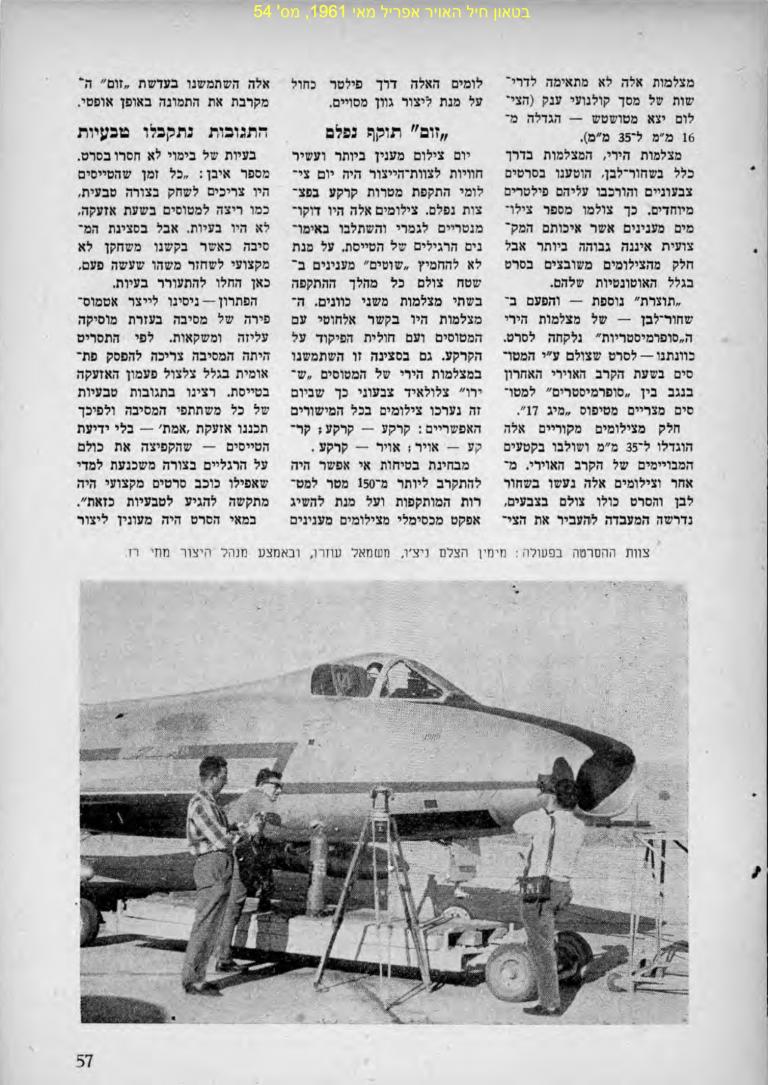
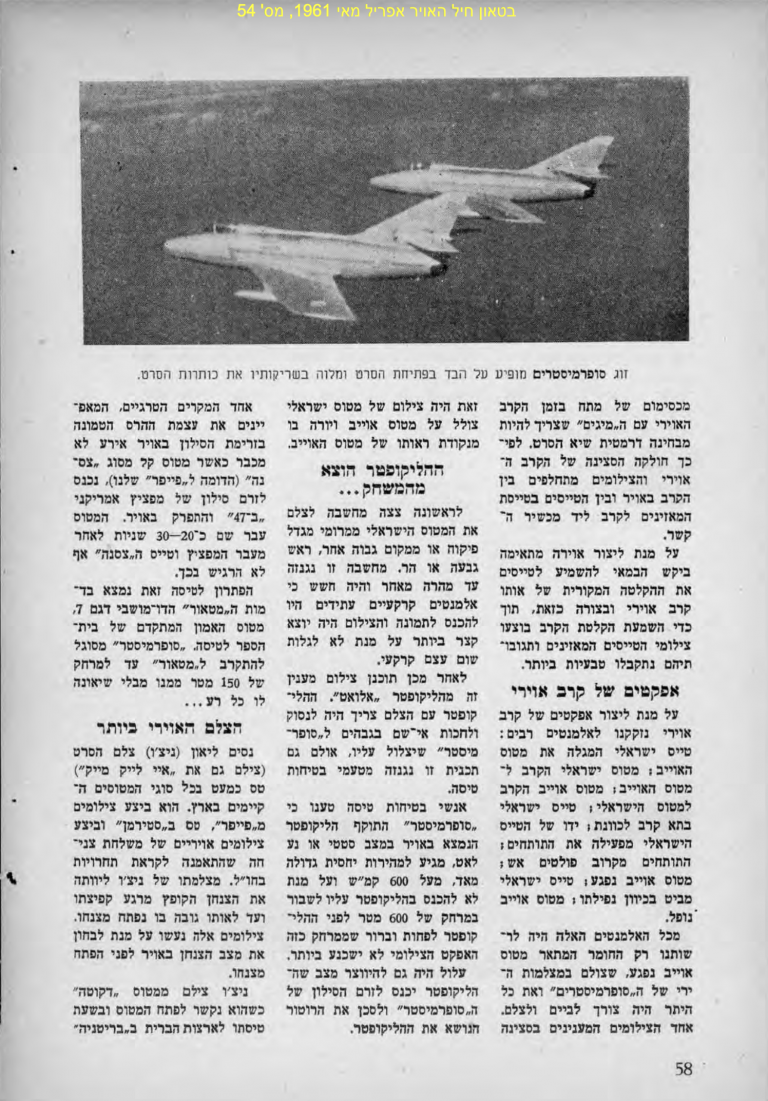

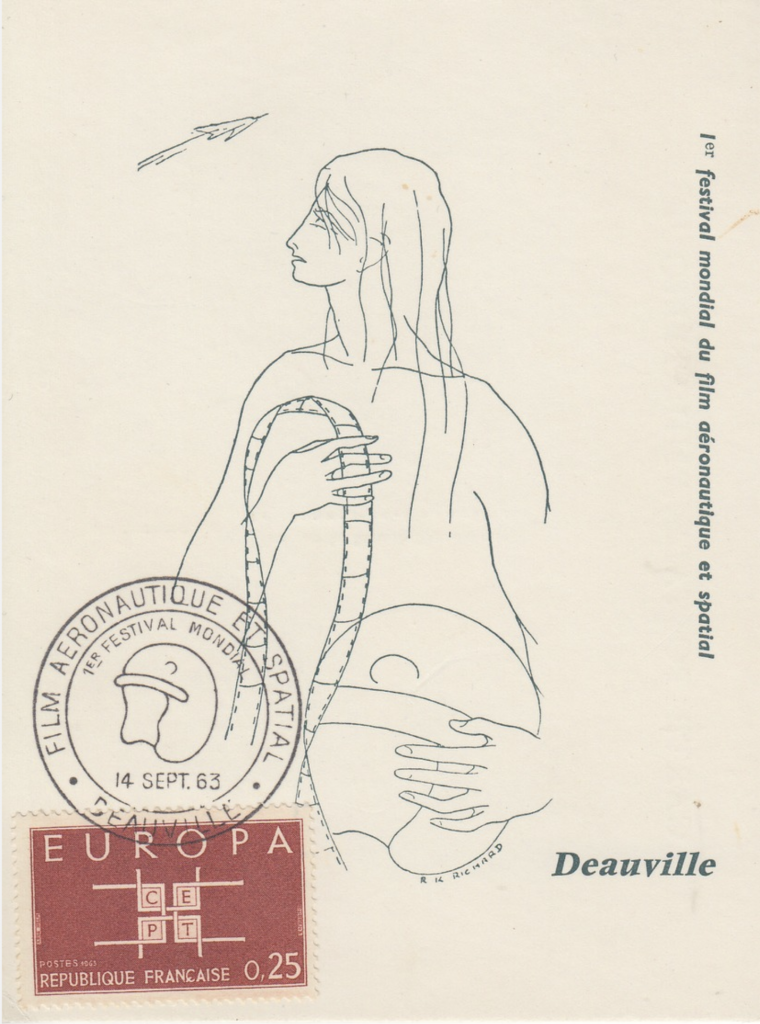
The Aerospace Film Festival in Deauville, France in 1963
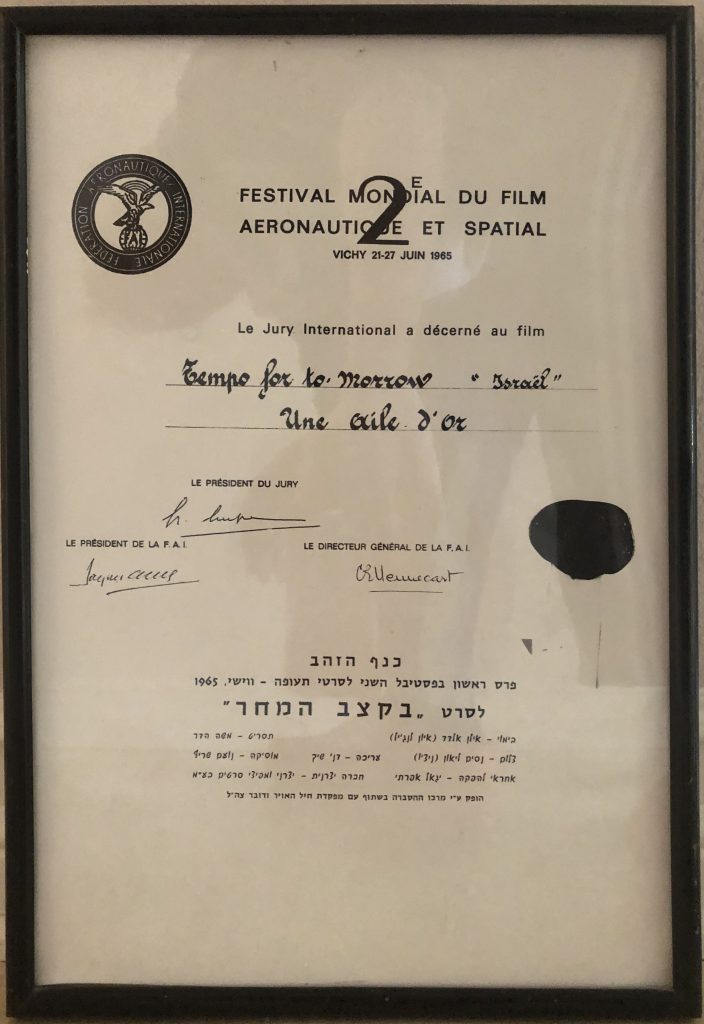
The Rhythm of Tomorrow - 1965
Won the Golden Wing, "The Rhythm of Tomorrow," at the International Film Festival, Aeronautics, and Space Conquest in Vichy, France, June 21-27, 1965.
The film deals with the training of cadets at the Israeli Air Force Technical School in Haifa. Its role is to encourage volunteering to the Air Force and studying the various electronics jobs at the Air Force Technical School. The film demonstrates, abrupt cuts and transitions of the evolution of technology in our life today.
The film begins with a short prologue that integrates into live shots, expressing the yearning to the skies, focusing on directing teenagers to technical careers in aviation – into the world of tomorrow.
At the center of the film is the Air Force Technical School in Haifa, the home of the Corps ground crews.
Aircraft mechanics, electrical and instrumentation and electronics, all combined with fast-paced film editing, incorporating images from the world of nature and the world of yesteryear to innovative ideas and dazzling activities of the careers of tomorrow. careers.
One of the "sequences" of the movie start by a cross-sectional “Marbore” engine, which is installed into the "Fouga" airplanes, used in the IAF’s flight school. From the "Marbore" the camera fades to a group of spectacular butterflies from the butterflies to the Fouga butterfly-like tail and hereafter to the IAF’s flying aerobatic team, which prompted many of the viewers of its spectacular military aviation flyover during the IDF’s Independence Day parade.
Certificates of Appreciation
In October 1965, the commander of the Air Force, Major General Ezer Weizman (middle right), decided to award the filmmakers of "The Rhythm of Tomorrow" certificates of appreciation for their effective craft. At a brief ceremony held in his office, the diplomas were handed over by the Air Force's Division of human resources, Brigadier General Peleg Tamir. On the left, in the middle, the screenwriter, Moshe "Pommy" Hadar
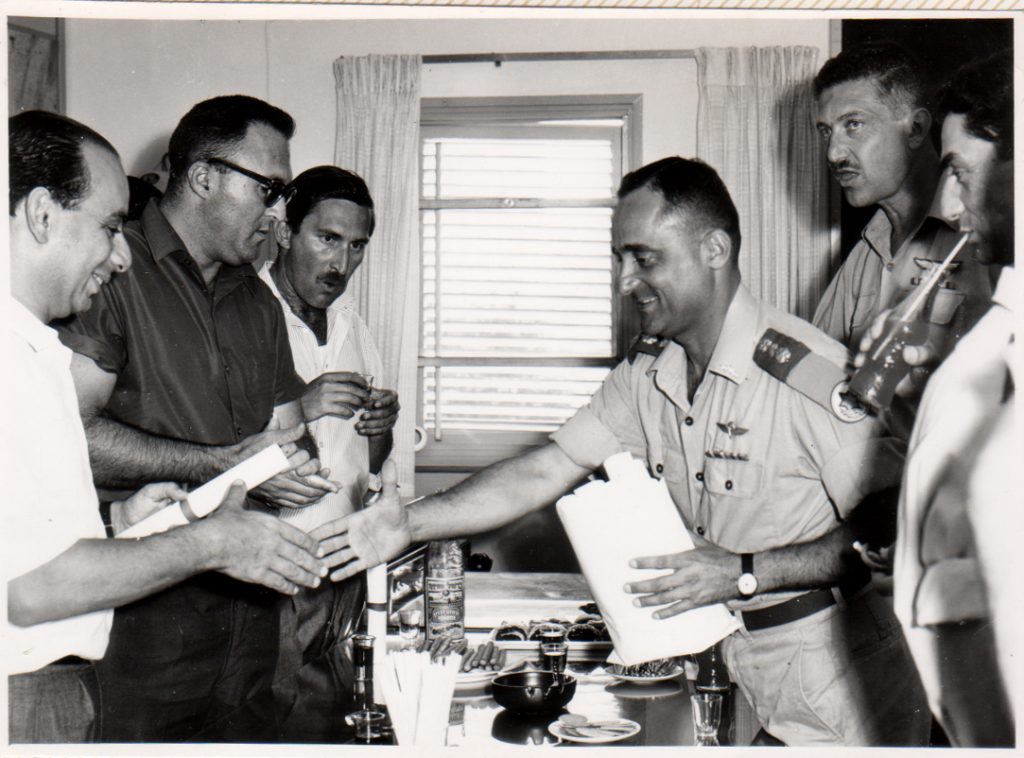
SIX
HOURS
IN JUNE

Six Hours in June - 1967
The film is 90 minutes long and shows documentary reconstruction of the Air Force operations during the Six Day War. The combat effort in the air and the commitment of the ground crews that made it possible. Dog fights, original footage of Egyptian airfield attacks, as taken by Israeli gun cameras and pilot-to-pilot communication. Propaganda campaign of fear and hysteria as well as the instructional demagogic films of the Arabs. The personal stories of Air Force personnel are authentically recreated.
According to the article, "The best to fly are also the best in film making" by Talila Ben-Zakai, Ma’ariv Newspaper, December 13, 1967, it turns out that at the time of the outbreak of the war, Pommy was in the midst of writing a docudrama about the uniqueness of Mirage fighter plane and the other new aircrafts. “The October 1966 incident in which Mirage shutdown two MiG 19s was the basis for the script”, Pommy told the reporter. He went on and continued, "Preparations for the film were completed, until suddenly, on April 7, 1967, an incident occurred in the northern part of the country, shooting down six Serian Mig Jet fighters’ planes. In light of that development, the script seemed outdated. Of course, I immediately sat down to change the script according to the IAF achievements. But very quickly we reached the period of volatile, uncertainty and ambiguous environment as well as 24/7 preparedness.
Any thoughts of producing an informational film was rejected. When the war broke out on June 5, and our planes began arriving back from their missions, and the upper commanders screened the live footage from the gun cameras, we felt that we had the right material for a film on the corps.
Then and there it was decided, to make every effort to shoot more and more footage, and try to encompass all aspects of the IAF effort.” Pommy immediately, recruited to military duty the director, Ilan Eldad, the lead photographer, Nissim Leon and other professional photographers were sent on special duty. In addition, dozens of members of the corps were photographed during the conflict, or on reconnaissance and liaison aircrafts over the combat zones, on all fronts.
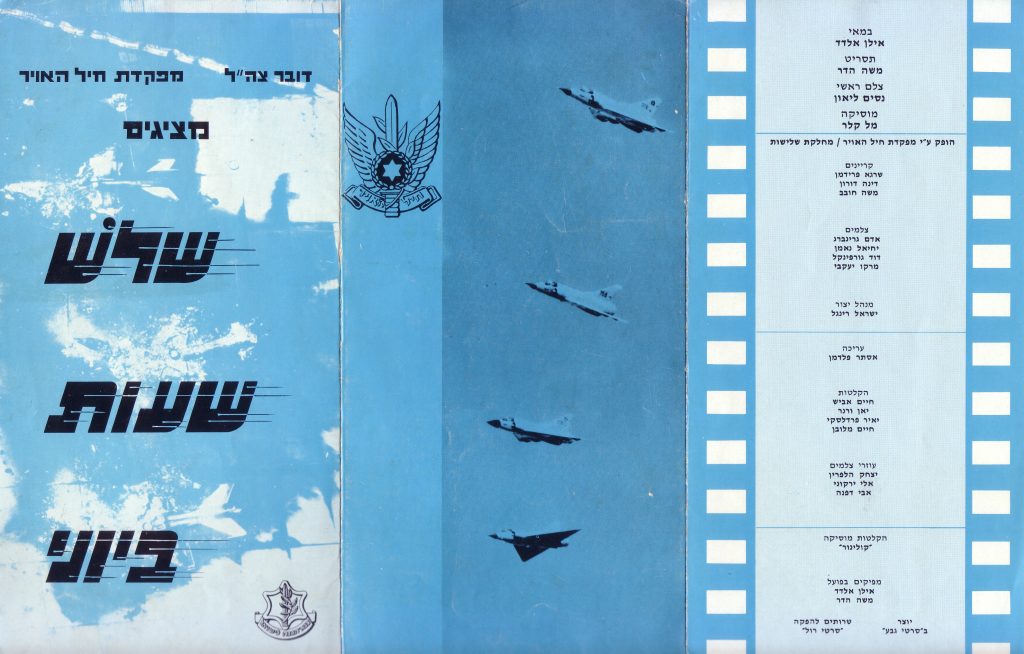
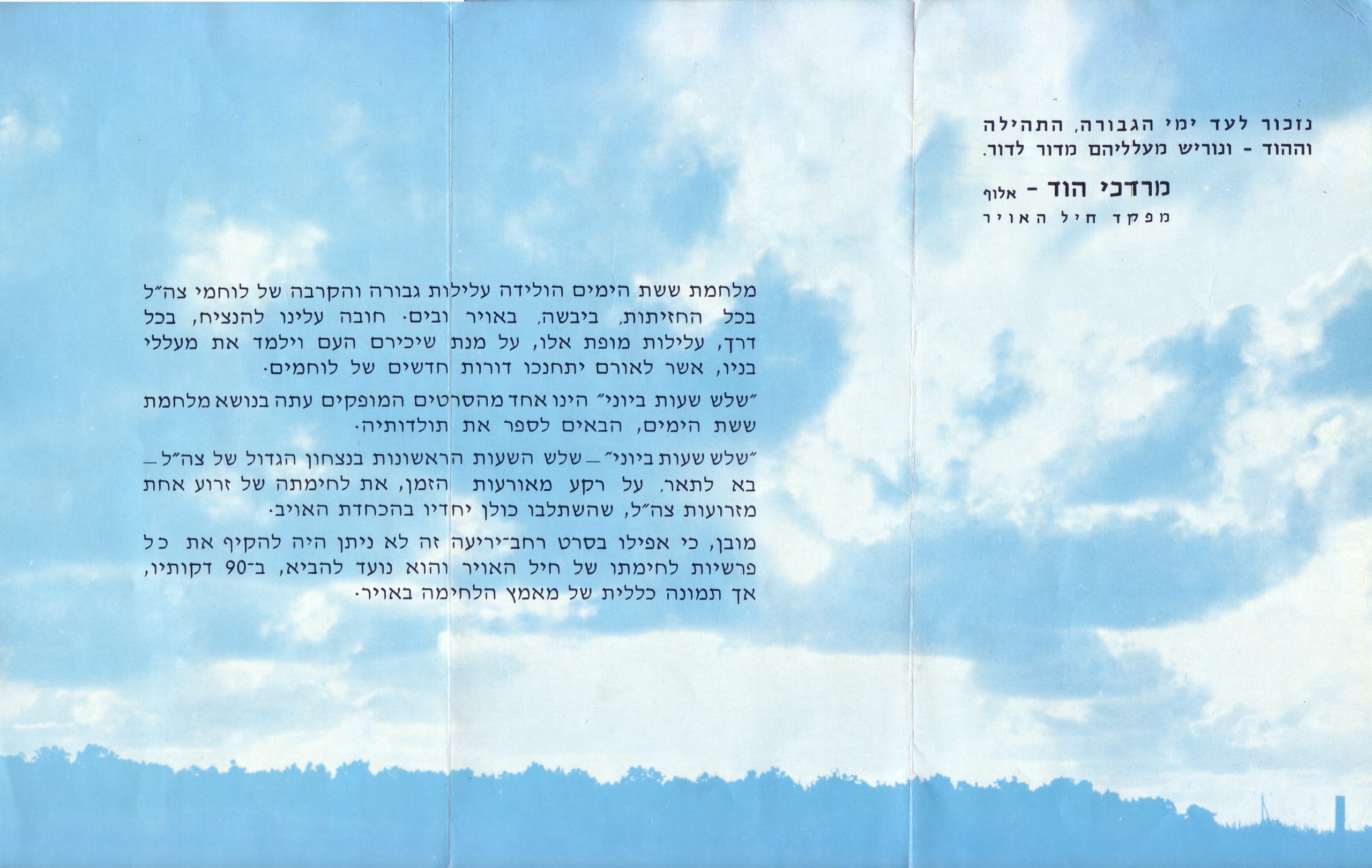
THE BLACK SPITFIRE
NOVEMBER 1970
The Black Spitfire – from the series "Thanks to Those Days”, a program about the Israeli Air Force. The Black Spitfire, the last of the 1948 aircraft, in flight, an overview of the development of aviation in Israel – from the first aviation clubs to the establishment of the Air Force, purchase of aircraft, Spitfires, Dakotas and more. Interviews with key personnel and pilots in the Air Force then and in the early 1970s.
The Supermarine Spitfire is a British single-seat fighter aircraft that was used by the Royal Air Force and other Allied countries before, during, and after World War II. Many variants of the Spitfire were built, using several wing configurations, and it was produced in greater numbers than any other British aircraft. The Supermarine Spitfire LF Mk IXEs, the first of which, "Israel 1" was locally assembled from British abandoned spare parts and a salvaged engine from an Egyptian Spitfire with most of the rest purchased from Czechoslovakia.
The “Black Spit(fire),” shown in this movie, joined the Royal Air Force in May 29, 1945, was transferred to the Czech Air Force and then sold to Israel in October 1948. The plane arrived in Israel in November 1949, received the number 2057, and entered service in the “First Fighter” Squadron. It was then used for training purposes in the “Scorpion” squadron and the “Third Spitfire” Squadron, known today as the “Knights of the Orange Tail” Squadron ( now flying F-16I Sufa). In 1954, most of Israel’s Spitfires were sold to Burma, but a few planes remained in Israel at the initiative of Major General Ezer Weizman, the then-Commander of Ramat David Airbase. One of those planes was Spitfire 2057 (or 57 after shortening) which shortly afterwards became Weizman’s private plane and was painted black at its command to resemble the plane of the British Airbase Commander under which Weizman served during WWII. Weizman stuck with the “Black Spit” even after completing his army service and kept flying it in IAF’s airshows. Wiezman’s association with the plane was so great that it was decided to fly it over cemetery, during his funeral.
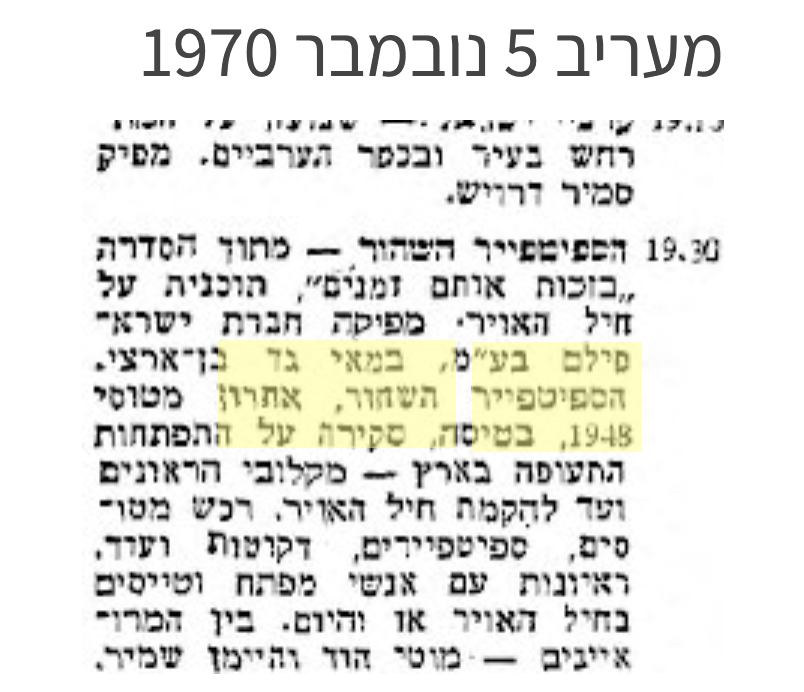
Mission Order 20 - 1971
The film shows the Air Force in the "Last Mission" before a cease-fire
WINGS – Iraq Nuclear reactor bombing, 1981
Wings is docudrama about the attack on the Iraqi atomic reactor and its destruction by IAF fighter jets, a rare look through the aircraft's front and rear sight.
What exactly happened there and how did the air force function?
The plot portrays three pilot cadets. The audience see the path they take throughout the course until their graduation ceremony and receiving of the wings. Each of the new pilots is assigned for further training, in the areas of combat, helicopter and navigation. The highlight of the movie is that all three of the original cadets participate in the Iraqi reactor attack.
The purpose of Operation Opera was to prevent the use of nuclear weapons that would endanger Israel's existence. What exactly happened after Israel realized that all diplomatic negotiations and clandestine operations got exhausted. Menachem Begin’s government had reached the point-of-no-return and concluded that a preemptive attack was necessary. (see "The Battle Against Osirak Findings from Saddam's Palace"By Lieutenant, Mili Uri Fields). The General Staff considered different ways of action and finally the decision was made and on 7 June 1981, a flight of Israeli Air Force F-16A fighters’ aircraft, with an escort of F-15As, bombed and heavily damaged the Osirak reactor. The reactor was destroyed less than a month to go before it might become critical! At the time, the attack was met with sharp international condemnations against Israel, including the United States.
Years later, Israel proved to have made a bold and wise move. In the years following the Gulf War, Saddam Hussein's intentions were revealed and the international community mobilized to contain it, praising the original reactor attack. In 1991, after the liberation of Kuwait, US Secretary of Defense, Dick Cheney sent Israeli Ambassador to the United States, David Avri, who was the commander of the Air Force at the time of the reactor attack, an American satellite image of the bombed-up reactor. He inscribed: "With appreciation thank you. You eased our missions in Desert Storm.”
On March 13, 1983, Pommy received a token of appreciation, a photo (see above) from Brigadier General Jacob Turner (Head of HQ), in which he wrote: "Dear Pommy, the film Wings – the story of the Israeli Air Force, the events and experiences of a great corps and you have a big part in it. With appreciation and thank you, Yaakov Turner Brigadier General, Head of the IAF Group."
Pommy and the rest of “the group” stayed in the pit during Operation Opera, until all the planes returned safely to base.
Attached is the 1982 Air Force Report on Operation Opera. Information courtesy of the IDF Archives and the security system.pilot cadets
TOP SECRET
